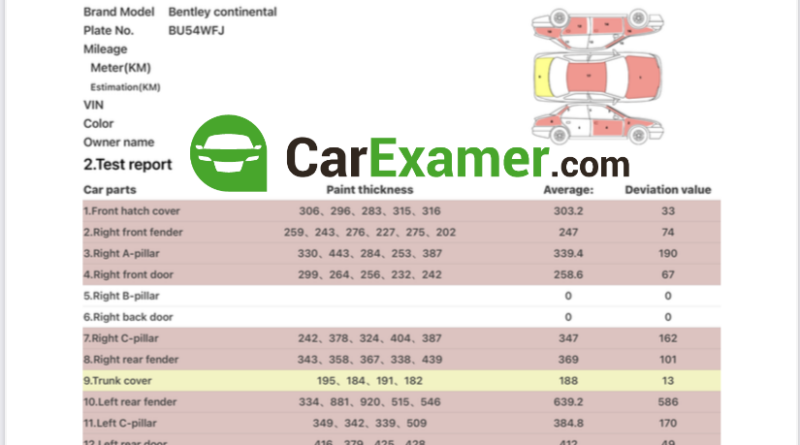Automotive Paint Thickness Readings and Standards
This article explores the importance of automotive paint thickness readings, the tools used for measurement, industry standards, and best practices for achieving optimal results. Maintaining the aesthetics and integrity of a vehicle’s exterior involves understanding automotive paint thickness readings and standards. Accurate paint thickness measurements are crucial for ensuring quality paint jobs, detecting previous repairs, and preventing corrosion.
Importance of Paint Thickness Readings
- Quality Assurance: Consistent paint thickness is vital for achieving a uniform finish and maintaining the vehicle’s appearance.
- Corrosion Prevention: Adequate paint thickness protects the underlying metal from environmental elements, reducing the risk of rust and corrosion.
- Repair Verification: Paint thickness readings can reveal previous repairs, resprays, or the application of body filler, providing valuable information for vehicle inspections and valuations.
- Warranty Compliance: Adhering to manufacturer’s paint thickness standards is essential for warranty claims and ensuring long-term durability.
Tools for Measuring Paint Thickness
Several tools and techniques are used to measure automotive paint thickness:
- Magnetic Induction Gauges: These devices use magnetic fields to measure the thickness of non-magnetic coatings on ferrous substrates. They are commonly used for steel panels.
- Eddy Current Gauges: These are used to measure non-conductive coatings on non-ferrous substrates, such as aluminum. Eddy current gauges are ideal for modern vehicles with aluminum bodies.
- Ultrasonic Gauges: These devices use ultrasonic waves to measure paint thickness on a variety of substrates, including composites and plastics. They are highly accurate and can measure multiple layers of paint.
- Digital Coating Thickness Gauges: These portable, easy-to-use devices provide quick and accurate readings, making them popular in both professional and DIY settings.
Industry Standards for Paint Thickness
Paint thickness standards vary depending on the vehicle manufacturer and the type of coating applied. However, general guidelines are as follows:
- OEM Paint Thickness: On modern cars original Equipment Manufacturer (OEM) paint typically ranges from 100 to 150 micrometres (µm) microns. This includes primer, basecoat, and clearcoat layers. There is exception to this rule as special paintwork used by manufacturer 3 layer for example, luxury car paint thickness readings can be higher 150-200 micrometres (µm) microns.
- Repaint Thickness: Repainted surfaces often have thicker coatings, ranging from 150 to 300 µm, due to additional layers of primer and paint.
- Paint Layer Thickness: Modern cars Primer layer thickness ranges between 8 microns (µm) and 38 microns (µm). Basecoat layer thickness ranges from 13 microns (µm) to 38 microns (µm). The clearcoat layer (lacquer) , which provides gloss and protection, usually measures between 30 and 50 µm.
Best Practices for Measuring Paint Thickness
To ensure accurate and consistent paint thickness readings, follow these best practices:
- Calibrate the Gauge: Before taking measurements, calibrate the gauge using standard reference blocks to ensure accuracy.
- Clean the Surface: Remove any dirt, dust, or contaminants from the surface to avoid interference with the readings.
- Take Multiple Readings: Measure paint thickness at multiple points across the panel to account for variations and identify any inconsistencies.
- Document the Readings: Keep a record of the measurements for future reference, particularly when assessing repairs or conducting inspections.
- Understand Substrate Material: Different substrates require different measurement techniques. Ensure the appropriate gauge is used for the material being measured.
Interpreting Paint Thickness Readings
Interpreting paint thickness readings involves understanding the context and comparing the measurements to industry standards:
- Consistent Thickness: Uniform readings across a panel indicate a high-quality paint job with consistent application.
- Variations in Thickness: Significant variations may suggest previous repairs, uneven application, or the presence of body filler.
- Excessive Thickness: Readings above the standard range can indicate multiple paint layers, potentially due to resprays or repairs.
- Thin Coatings: Readings below the standard range may suggest inadequate protection, increasing the risk of corrosion and damage.
Conclusion
Understanding automotive paint thickness readings and standards is essential for maintaining vehicle aesthetics, ensuring quality repairs, and protecting against corrosion. Utilizing the right tools and following best practices for measurement can help achieve optimal results. Whether you’re a professional in the auto body industry or a car enthusiast, accurate paint thickness readings are a crucial aspect of vehicle maintenance and inspection.
Buying a used VW. Buying used vauxhall, BMW, Jaguar, Ford, Volvo, Range rover, Bentley, Aston Martin, Porsche, Ferrari, Lamborghini, Maserati, Hyundai, Tesla, Honda, Pagani

